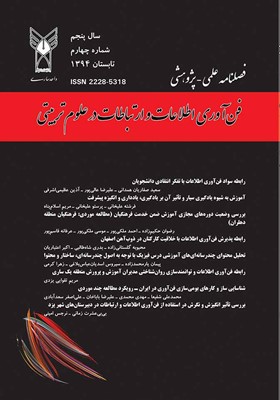بررسی وضعیت دورههای مجازی آموزش ضمن خدمت فرهنگیان (مطالعه موردی: فرهنگیان منطقه دهلران)
محورهای موضوعی : مدیریت آموزشیرضوان حکیم زاده 1 , احمد ملکی پور 2 * , موسی ملکی پور 3 , عرفانه قاسم پور 4
1 - دانشیار گروه برنامهریزی درسی، دانشگاه تهران، تهران، ایران
2 - دانشجوی دکتری برنامهریزی درسی، دانشگاه تهران، تهران، ایران
3 - دکتری برنامهریزی شهری، دبیر آموزش و پرورش دهلران، ایلام، ایران
4 - دانشجوی دکتری برنامهریزی درسی، دانشگاه تهران، تهران، ایران
کلید واژه: آموزش و پرورش, آموزش مجازی, آموزش ضمن خدمت, فرهنگیان,
چکیده مقاله :
هدف پژوهش حاضر، بررسی وضعیت موجود دورههای مجازی آموزش ضمن خدمت فرهنگیان میباشد. این تحقیق از نوع توصیفی بوده که با استفاده از روش پیمایشی انجام شده است. جامعه آماری به تعداد 881 نفر از فرهنگیان منطقه دهلران در سال 1393 است. حجم نمونه با استفاده از جدول کرجسی و مورگان، 267 نفر تعیین شد. با استفاده از روش نمونهگیری طبقه ای، 134 مرد و 133 زن به عنوان نمونه انتخاب شدند، که به پرسشنامه محققساختهای که بر اساس مبانی نظری پژوهش و تحقیقات پیشین تهیه شده بود، پاسخ دادند. روایی محتوایی و صوری پرسشنامه با استفاده از نظر جمعی از متخصصان و کارشناسان دورههای آموزش مجازی به دست آمد و پایایی پرسشنامه با استفاده از ضریب آلفای کرونباخ، 0/88 محاسبه شد. به منظور تجزیه و تحلیل دادهها از آزمون کلموگروف اسمیرنف و آزمون دوجمله ای (نسبتها) استفاده شد. نتایج نشان داد که عدم تدارک زیرساختها و امکانات لازم جهت اثربخشی دورههای آموزش مجازی، و عدم اثربخشی دورههای آموزش مجازی نسبت به دورههای حضوری از چالشهای موجود است. همچنین، همخوانی دورههای آموزشی با نیازهای فرهنگیان و کسب مهارتهای لازم برای استفاده اثربخش دورههای آموزش مجازی ضمن خدمت را میتوان به دیده فرصت نگریست.
The purpose of this study was to investigate the virtual courses of educators’ in-service training. This research adopted a descriptive approach to conduct the study using survey method. Its statistical population consisted of 881 teachers in Dehloran in 2014. Using the stratified sampling, the sample size was determined as 267 persons by Morgan and Krejcie table, of whom 134 were men and 133 were women who answered the researcher-made questionnaire being prepared based on theoretical foundations of the study as well as previous studies. Face and content validities of the questionnaire were also confirmed using the ideas of a number of experts and specialists of virtual training courses, and the questionnaire reliability was estimated as 0.88 using Chronbach's alpha coefficient. The Kolmogorov Smirnov and Binominal (proportions) tests were used to analyze the data. The results showed that the lack of provision of necessary infrastructures and facilities for virtual training courses effectiveness and lack of the virtual training courses effectiveness compared to attending courses sit among the challenges. Moreover, educational courses compatible with the needs of educators and acquisition of necessary skills for effective use of in-service virtual training courses can be seen as opportunities.

